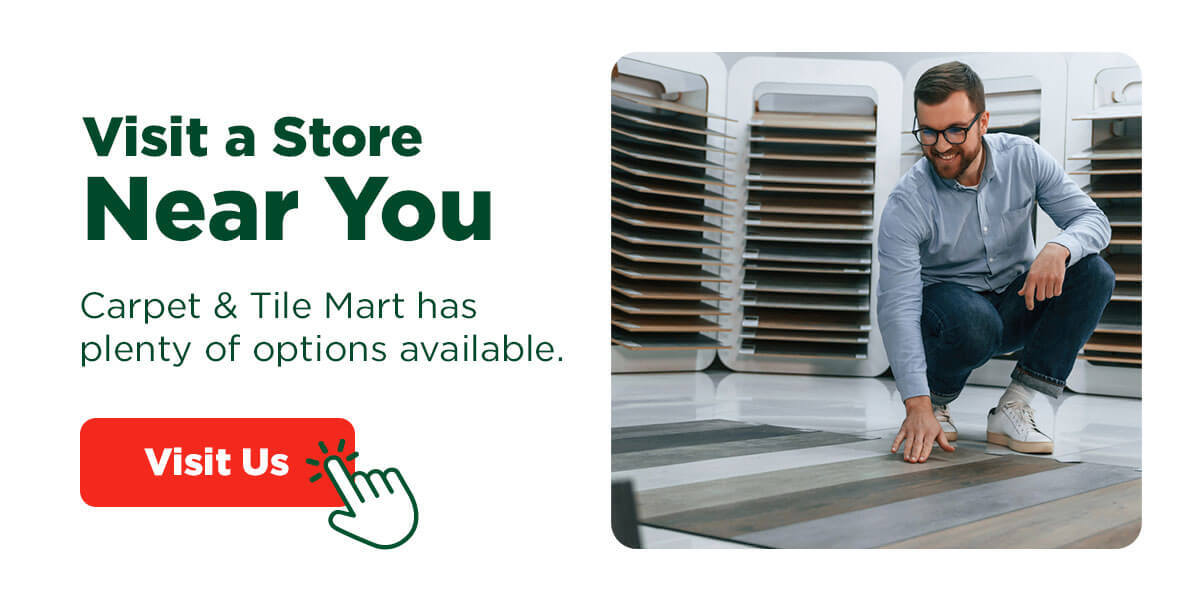Flooring Glossary of Terms
Posted by Ben Garelick (@BlueShirtBenny) on 16th Jun 2025
If you're looking to invest in new flooring for your home, understanding a few general words, phrases and jargon can aid your search and help you make a more informed decision. To streamline your research, we created this nifty flooring glossary to summarize some key terms.
Glossary of Common Flooring Terms
Let's explore some basic flooring terminology for five popular flooring types — carpet, hardwood, laminate, tile and vinyl.
1. Carpet
Carpet offers several benefits for a home, including comfort, warmth, insulation and noise reduction. Here are some standard carpet flooring terms to know:
- Berber: Berber is a style of carpet with uncut, tightly woven looped pile. This design creates a distinct textured appearance and includes an overall light base color with random flecks of darker color.
- Cut pile: This type of carpet has cut yarn loops. This construction creates upright fibers and individual tufts, providing a soft, plush and comfortable feel underfoot.
- Density: Carpet density describes the amount of pile yarn and how closely the tufts are packed together. Typically, denser pile indicates better durability and performance.
- Frieze: This style of cut-pile carpet contains tightly twisted yarn fibers, creating a curly, textured and casual appearance.
- Padding: Also known as underlayment, padding is a foam cushion placed under the carpet for enhanced performance, comfort and insulation.
- Pile: Carpet pile refers to the upright ends of yarn, which are either cut or left as loops. It determines the carpet's overall feel, appearance and maintenance needs. There are two main types — low pile has short, tightly woven fibers less than ¼ inch in height, while high pile contains longer fibers measuring between ½ inch and ¾ inch.
- Saxony: Saxony is a type of cut-pile carpet with long, twisted, densely woven fibers that stand up straight. This design creates a smooth, even surface with a soft underfoot feel.
- Tufted carpet: Tufting uses a needle to insert yarn into a backing material, which forms either cut fibers or loops. This efficient, cost-effective process allows for various colors, patterns and textures.
- Woven carpet: Woven carpet is manufactured on a loom. The lengthwise and widthwise yarns are interlaced to create the fabric. This process forms more intricate patterns and textures, and it's more expensive, time-consuming and labor-intensive than tufting.

2. Hardwood
Hardwood flooring is known for its timeless aesthetic and ability to increase home value, making it an appealing option for many homeowners. Some basic terms surrounding hardwood flooring include:
- Distressed hardwood: Distressing is a process used to give wood flooring a worn, aged appearance, creating a rustic or vintage aesthetic. It incorporates techniques like brushing, scraping and weathering to add imperfections to the surface of the planks for added character.
- Engineered hardwood: This type of hardwood flooring is manufactured from multiple layers of wood. It usually has a high-density fiberboard (HDF) or plywood core with a real wood veneer on top. This construction provides superior strength and dimensional stability. It makes the flooring less susceptible to warping from temperature and humidity fluctuations.
- Hardness/Janka rating: Hardwood hardness is typically measured using the Janka scale. A higher Janka rating means the wood is more resistant to scratches, dents and wear. For example, Brazilian cherry has a Janka hardness rating of at least 2,160, far exceeding the industry standard. This makes it an excellent choice for high-traffic areas like kitchens and living rooms.
- Solid hardwood: Solid hardwood differs from engineered hardwood because it's made from a single piece of wood, milled directly from a tree. This construction creates a consistent, uniform appearance throughout the plank. Popular species include cherry, maple, walnut, oak and hickory.
3. Laminate
Laminate is a synthetic, multilayered flooring designed to emulate the look of natural hardwood or tile. The following terms can help you better understand the design and production process:
- Abrasion Class (AC) rating: The AC rating measures the laminate flooring's resistance to impact, abrasion and stains. Higher AC ratings typically indicate greater durability.
- Core layer: The core layer is the thickest inner layer of the laminate floor, generally made of medium-density fiberboard (MDF) or HDF. This central layer offers structural support and moisture resistance.
- Decorative layer: The decorative surface layer is the high-resolution photograph of wood or stone, applied to the core layer.
- Wear layer: This is the top, durable layer of the laminate floor, protecting the decorative layer against scratches, indentations and stains.
4. Tile
Tile flooring is highly durable, visually pleasing and easy to clean, and it offers an array of materials, colors and textures. The terms below can help you understand your design options:
- Ceramic: Ceramic tiles are made of inorganic materials like clay, water and sand. The material is shaped while still wet — once dry, it's fired and hardened in a high-temperature kiln to create a durable surface. The tile is then coated with a specialized glaze to create a water- and stain-resistant seal.
- Mosaic: Mosaic is a type of design consisting of many small pieces of tile. These tiles come in various colors, patterns and finishes, suiting a range of aesthetic preferences. Materials can include stone, ceramic, glass, metal and porcelain in different sizes and shapes. You can arrange the tiles to create a custom pattern for your floor.
- Porcelain: Porcelain tiles consist of clay and other materials fired in a high-temperature kiln. Their dense, durable nature provides excellent resistance to moisture, chipping, scratches and fading.
- Stone: Stone tiles are made of natural materials, such as limestone, marble, travertine and slate, offering unique colors, textures and veining. A popular design option for both interior and exterior spaces is ledger stone, which contains thin, flat pieces of natural stone arranged in a stacked or staggered pattern.
- Wall tile: Wall tiles incorporate thin, lightweight designs that are ideal for accent walls and backsplashes. Depending on your design preferences, materials can range from smooth to rugged, including stone, wood, metal or ceramic.
5. Vinyl
Luxury vinyl flooring is a go-to option for its ability to imitate the look of natural materials, such as wood and stone, while offering extra durability, low maintenance and affordability. Here are some important terms to note:
- Gauge: Gauge describes the thickness of the vinyl flooring, whether planks, tiles or sheet vinyl. A thicker gauge often translates to greater durability.
- Luxury vinyl plank (LVP): LVP flooring is designed to mimic the look of real hardwood, but it offers greater durability, water resistance and affordability. Rather than individual tiles or one large sheet of vinyl, it's made up of planks.
- Luxury vinyl tile (LVT): LVT flooring can simulate the appearance of natural tile materials like stone, travertine, ceramic and marble — all while providing lower costs, waterproof properties and scratch resistance.
- Sheet vinyl: Sheet vinyl flooring comes in a single large roll, minimizing the number of visible seams after installation. Instead of planks or tiles, it's designed with continuous flexible sheets. Sheet vinyl is a durable, low-maintenance, cost-effective choice for traffic-heavy, moisture-prone spaces like bathrooms, laundry rooms and kitchens.
- Wear layer: This is the top, transparent layer that protects the vinyl flooring from wear and tear. A thicker wear layer usually indicates better performance.
Visit a Store Near You or Contact Our Flooring Experts
Whether you're leaning toward carpet, hardwood, laminate, tile or vinyl for your space, Carpet & Tile Mart has plenty of options available. Our broad inventory makes it easy to find flooring in your preferred materials, styles and colors. Find a store near you, or contact us with questions about selecting the right flooring for your home!




